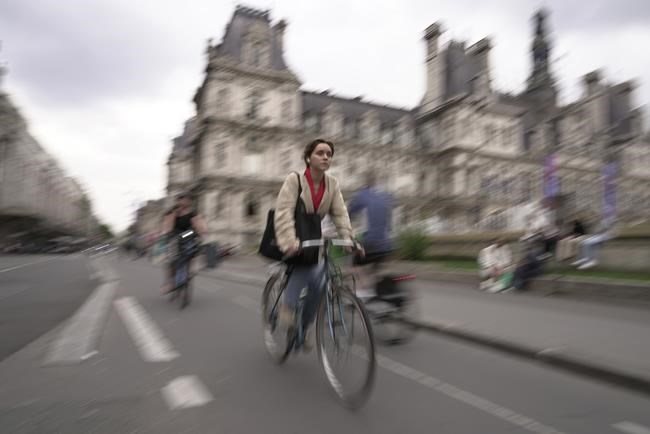
A woman rides past Paris city hall, in Paris, Wednesday, Sept. 13, 2023. Years of efforts to turn car-congested Paris into a more bike-friendly city are paying off ahead of the 2024 Olympics, with increasing numbers of people using the French capital's growing network of cycle lanes. (AP Photo/John Leicester)
Republished September 27, 2023 - 10:48 PM
Original Publication Date September 27, 2023 - 8:06 PM
PARIS (AP) — Ring, ring! It's rush hour on Paris' Sébastopol Boulevard, and the congestion is severe — not just gas-guzzling, pollution-spewing, horn-honking snarls but also quieter and greener bottlenecks of cyclists jockeying for space.
Until four years ago, motorists largely had the Paris thoroughfare to themselves. Now, its bike-lane jams speak to a cycling revolution that is reshaping the capital of France — long a country of car-lovers, home to Renault, Citroen and Peugeot.
This revolution, like others, is also proving choppy. A nearly decade-long drive by Socialist Mayor Anne Hidalgo to turn Paris from a city hostile for cyclists — except those racing the Tour de France — into one where they venture more safely and freely has become so transformative that bikes are steadily muscling aside motor vehicles and increasingly getting in each other's way. And more bike lanes are coming for next year's Paris Olympics — part of an effort to halve the event's carbon footprint.
Already, on some Paris boulevards, bikes outnumber cars at peak times. Cycle congestion, with wheel-to-wheel lines of riders ringing their bells and sometimes losing their cool, is becoming a headache.
“It’s the same feeling as the one I had when I was younger, with my parents driving their car, and it was like traffic jams all over the place. So now it’s really a bike traffic jam,” said Thibault Quéré, a spokesperson for the Federation of Bicycle Users. “But it’s kind of a good difficulty to have. Especially when we think about what Paris used to be.”
From a measly 200 kilometers (125 miles) in 2001, cyclists now have more than 1,000 (620 miles) of tailor-made bike paths and marked routes to roam, City Hall says. Motor vehicles have been barred entirely from some roads, most notably a River Seine embankment that used to be a busy highway. It's become a central Paris haven for cyclists, runners, families and romantics since Hidalgo closed it to motor traffic in 2016.
Farther north, the twin-lane bike path on Sébastopol Boulevard has become one of Europe’s busiest since its inauguration in 2019. It saw a record 124,000 weekly users in early September, according to tracking by pro-bike group Paris en Selle ("Paris by saddle"). Traffic there now regularly surpasses London's busiest cycleways and at its busiest even approaches the numbers of popular cycle routes in Amsterdam.
North-south Sébastopol empties into another busy east-west route on Rue de Rivoli that passes the Louvre. It also saw record daily and weekly numbers in September, Paris en Selle's tracking shows.
Add to the mix none-too-thrilled motorists, scooters wriggling through traffic, pedestrians trying not to get squished and construction that seems to have popped up almost everywhere in Paris’ sprint to the Olympics, and negotiating the busiest streets by bike can feel akin to playing Mario Kart — but with real-life dangers and consequences.
Many cyclists, some clearly new and still feeling their way around, seem to think red lights and road rules don’t apply to them. Paris' removal of for-hire electric scooters following a city referendum in April also is driving some ex-users to biking.
“Paris has become unlivable. No one can stand each other,” bike-rider Michel Gelernt said as he wound his way past whistle-blowing traffic officers and yelling motorists on Concorde plaza, the French Revolution decapitation site of King Louis XVI in 1793.
A former motor-scooter and public-transport user, the retiree switched to cycling during the COVID-19 pandemic and has kept the habit. He uses Velib' — Paris' bike-sharing system, in its 16th year — to get around for 80% of his trips.
“Everyone behaves selfishly,” grumbled Gelernt, who's in his 70s. "The traffic is a lot worse than it was."
That said, he and others can't dispute that flows of bikes are better for health and the environment than the noxious pollution that still often blankets Paris. France's government blames atmospheric pollution for 48,000 premature deaths nationwide per year.
In a landmark decision, a Paris court in June awarded 5,000 euros ($5,300) in compensation to two families with children who were sickened by air pollution, suffering from asthma and other health issues when they lived near the capital's car-choked ring road. The court ruled the French state was at fault.
Hidalgo cites pollution as a prime motivation for her drive to increase bike use, squeeze out emission-spewing vehicles and make “a Paris that breathes.” Re-elected in 2020, her second five-year “Bike Plan” budgets 250 million euros ($260 million) in additional investments by 2026. That's 100 million euros more than on her first-term bike plan. Most of it is earmarked for more cycle routes and parking.
City Hall says all Olympic venues in the city will be bike-accessible for the July 26-Aug. 11 Paris Games, on a 60-kilometer (nearly 40-mile) cycle network.
So Olympic fans will be able discover what growing numbers of Parisians are learning: Experiencing the city by bike can rekindle love for its charms.
Behind busy thoroughfares are countless quieter streets that embrace cyclists with sights, sounds and smells that are too easily missed by car. And for a start-the-day jolt to energize the senses without over-priced espresso, try bouncing along the cobblestones of the Champs-Elysées on any crisp morning.
“It's a feeling of freedom, rather than being in the Metro, sitting down or in the heat,” said Ange Gadou, 19, a convert who previously relied on rental e-scooters before Paris banished them.
“There's nothing about it I don't like."
___
Associated Press journalist Alex Turnbull contributed.
News from © The Associated Press, 2023